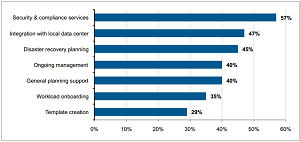When Cloud Projects Fail
Enterprises moving to the cloud is a given, most will agree, but new research suggests it's a bumpy ride, with "staggering" project failure rates.
Even among the most well-known Infrastructure as a Service (IaaS) providers, unexpected challenges derail many cloud implementations. These challenges include complicated pricing and hidden costs that erase expected cost savings, performance problems and more, according to the report: "Casualties of Cloud Wars: Customers Are Paying the Price."
The research was conducted by Enterprise Management Associates Inc. (EMA) and commissioned by cloud infrastructure providers Iland and VMware Inc. EMA recently surveyed more than 400 professionals around the world to gauge their IaaS implementation experiences with major vendors such as Amazon.com Inc., Microsoft and Rackspace.
 [Click on image for larger view.]
We need help! Respondents report what type of external support they require when operating a public cloud.
[Click on image for larger view.]
We need help! Respondents report what type of external support they require when operating a public cloud.
(source: iland)
"The promise of cloud remains tantalizingly out of reach, and in its place are technical headaches, pricing challenges and unexpectedly high operational costs," the report stated. Iland, in a statement announcing the study, said, "Respondents reported staggering failure rates across 'tech giant' IaaS implementations and identified the support and functionality needed to overcome top challenges."
As part of the survey, respondents were asked which public cloud services they considered, which were adopted, and which stalled or failed.
Rackspace was the leader in stalled/failure rates, named by 63 percent of respondents, followed by Amazon (57 percent), Microsoft Azure (44 percent) and, finally, VMware vCloud-based service providers, scoring the "best" with a 33 percent reported failure rate. Iland is a VMware-based cloud provider (and remember, Iland and VMware commissioned the study).
"Eighty-eight percent of respondents experienced at least one unexpected challenge," the survey said. "The most common challenge in the United States was support, while performance and downtime topped [Europe] and [Asia-Pacific] lists, respectively.
The unexpected challenges were primarily found in six areas (with the percentage of respondents listing each):
- Pricing -- 38 percent
- Performance -- 38 percent
- Support -- 36 percent
- Downtime -- 35 percent
- Management of cloud services -- 33 percent
- Scalability -- 33 percent
On pricing, the report stated: "While cost savings may be a key benefit of cloud, the current pricing models under which they operate are difficult to understand. A cursory glance at the pricing schemes of major public cloud providers demonstrates the need for the customer to carefully analyze pricing models and their own IT needs before committing to an option."
On performance, the report stated: "Different clouds are architected with different back-ends, and some are more susceptible to 'noisy neighbor' syndrome than others. For customers who are sensitive to variations in performance, this can impact the cloud experience."
Moving from challenges to solutions, respondents were asked what factors would make cloud services more accessible to their organizations. The responses were:
- Better management dashboard -- 52 percent
- More flexible virtual machine (VM) scaling -- 47 percent
- Easier resource scalability -- 48 percent
- Better VMware vSphere integration -- 45 percent
- More transparent pricing -- 43 percent
- Simpler onboarding -- 37 percent
- Certainty of geographic location of workloads -- 35 percent
"Finally, respondents were nearly unanimous in their agreement that high-quality, highly available phone-based support was critical to their cloud implementations," the study said. "This is notable, in part, because phone-based support is far from standard among public cloud companies, and more often than not, is accompanied by a high-cost support contract."
Despite the problems, the study revealed that almost 60 percent of respondents indicated an interest in adding cloud vendors. In contrast, fewer than 20 percent plan to quit the cloud because of security, cost, compliance or complexity issues.
Top factors influencing cloud adoption were listed as disaster recovery capabilities, cost, rapid scalability and deployment speed.
"Companies cannot afford to turn their backs on cloud computing, as it represents a key tool in the race for innovation across industries and around the world," the report stated in its summary.
Posted by David Ramel on 06/25/2014 at 12:49 PM